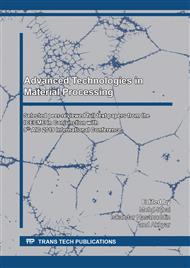[1]
V. Sata, C. Jaturapitakkul and K. Kiattikomol, Utilization of palm oil fuel ash in high-strength concrete, J. Mater. Civ. Eng. 16 (2004) 623-628.
DOI: 10.1061/(asce)0899-1561(2004)16:6(623)
Google Scholar
[2]
P. Chindaprasirt, S. Homwuttiwong and C. Jaturapitakkul, Strength and water permeability of concrete containing palm oil fuel ash and rice husk-bark ash, Constr. Build. Mater. 21 (2007) 1492-1499.
DOI: 10.1016/j.conbuildmat.2006.06.015
Google Scholar
[3]
M.N. Haque and O. Kayali, Properties of high strength concrete using affine fly ash, Cem. Concr. Res. 28 (1998) 1445-1452.
DOI: 10.1016/s0008-8846(98)00125-2
Google Scholar
[4]
C.S. Poon, L. Lam and Y.L. Wong, A study on high strength concrete prepared with large volumes of low calcium fly ash, Cem. Concr. Res. 30 (2000) 447-455.
DOI: 10.1016/s0008-8846(99)00271-9
Google Scholar
[5]
M. Hasan, S. Husin and C. Nursaniah, Mechanical properties of concrete in compression exposed to sulfuric acid, Key Engineering Materials 711 (2016) 302-309.
DOI: 10.4028/www.scientific.net/kem.711.302
Google Scholar
[6]
T.B. Aulia, Muttaqin, M. Afifuddin, M. Zaki and S. Merriza, Shear capacity analysis of high-strength reinforced concrete beams using geopolymer fly ash and palm oil blast furnace slag as additives and aggregate substitution, IOP Conf. Series: Mater. Sci. and Eng. 434 (2018) 012199.
DOI: 10.1088/1757-899x/434/1/012199
Google Scholar
[7]
Hamzani, Munirwansyah, M. Hasan, S. Sugiarto, The influence of the using waste tire rubber and natural zeolite as asphalt and cement replacement to compressive strength of semi-flexible pavement, IOP Conf. Series: Mater. Sci. and Eng. 523 (2019) 012034.
DOI: 10.1088/1757-899x/523/1/012037
Google Scholar
[8]
M. Hasan, Husaini, N.M. Abdullah, Deformation and crack analysis of tunnel structure subjected to static distributed load using Pseudoshell model, IOP Conf. Series: Mater. Sci. and Eng. 523 (2019) 012037.
DOI: 10.1088/1757-899x/523/1/012034
Google Scholar
[9]
ACI 211.4R-93, Guide for selecting proportions for high-strength concrete with Portland cement and fly ash, ACI Committee 211, reapproved (1998).
DOI: 10.14359/9754
Google Scholar
[10]
ASTM C78/78M, Standard test method for flexural strength of concrete (using simple beam with third-point loading), (2018).
DOI: 10.1520/c0078_c0078m-15b
Google Scholar
[11]
ASTM C496/496M, Standard test method for splitting tensile strength of cylindrical concrete specimens, (2017).
Google Scholar


